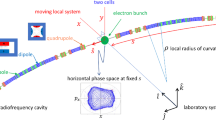Abstract
The separation of motions into slow (precession) and fast (nutation) components in the problem of the entry of a spacecraft (SC) with a small asymmetry into the atmosphere is considered. For the separation of the slow and fast motions the method of integral manifolds is used together with the asymptotic method for singularly perturbed systems. The separation of motions allows one to isolate the frequencies that are functions of the slow variables of a system, and further on, after determining the integer relations between them, to construct the resonant curves (surfaces). This method gives the possibility to analyze the conditions of the emergence of resonances for a SC at angles of attack that are not small and when aerodynamic characteristics are nonlinear. Examples of the construction of resonant curves for a SC with typical aerodynamic characteristics are considered.
Similar content being viewed by others
REFERENCES
Yaroshevskii, V.A., Dvizhenie Neupravlyaemogo Tela v Atmosfere (Motion of an Uncontrolled Body in the Atmosphere), Moscow: Mashinostroenie, 1978.
Aslanov, V.S., Two Types of Nonlinear Resonance Motion of an Asymmetric Spacecraft in the Atmosphere, Kosm. Issled., 1988, vol. 24, no. 2, pp. 220–226.
Zabolotnov, Yu.M., Asymptotic Analysis of Quasilinear Equations of Motion of a Spacecraft with Small Asymmetry in the Atmosphere. I, Kosm. Issled., 1993, vol. 31, no. 6, pp. 39–50.
Sidorenko, V.V., Capture and Escape from Resonance in the Dynamics of the Rigid Body in Viscous Medium, J. Nonlinear Sci., 1994, vol. 4, pp. 35–57.
Zabolotnov, Yu.M., A Method of Studying Resonance Motion of a Nonlinear Vibration System, Izv. Ross. Akad. Nauk, Mekh. Tverd. Tela, 1999, no. 1, pp. 33–45.
Shilov, A.A. and Goman, M.G., Resonance Modes of Spatial Uncontrolled Motion of Spacecraft at Their Reentry into the Atmosphere, Trudy TsAGI, 1975, no. 1624.
Belokonov, V.M., Belokonov, I.V., and Zabolotnov, Yu.M., A Shortcut Calculation of Descent Trajectories in the Atmosphere of Uncontrollable Spacecraft Taking Their Attitude Motion into Account, Kosm. Issled., 1983, vol. 21, no. 4, pp. 512–521.
Mitropol'skii, Yu.A. and Lykova, O.B., Integral'nye Mnogoobraziya v Nelineinoi Mekhanike (Integral Manifolds in Nonlinear Mechanics), Moscow: Nauka, 1973.
Strygin, V.V. and Sobolev, V.A., Razdelenie dvizhenii metodom integral'nykh mnogoobrazii (Separation of Motions by the Method of Integral Manifolds), Moscow: Nauka, 1988.
Vasil'eva, A.B. and Butuzov, V.F., Asimptoticheskie razlozheniya reshenii singulyarno vozmushchennykh uravnenii (Asymptotic Decompositions of Solutions for Singularly Perturbed Equations), Moscow: Nauka, 1973.
Zabolotnov, Yu.M. and Lyubimov, V.V., Secondary Resonance Effect in the Motion of a Spacecraft in the Atmosphere, Kosm. Issled., 1998, vol. 36, no. 2, pp. 206–214.
Sidorenko, V.V., Evolution of Motion of a Heavy Solid Body under the Action of Dissipative Perturbing Moment. II, Preprint of Keldysh Inst. of Applied Math., Russ. Acad. Sci., Moscow, 1991, no. 67.
Author information
Authors and Affiliations
Rights and permissions
About this article
Cite this article
Zabolotnov, Y.M., Lyubimov, V.V. Application of the Method of Integral Manifolds for Construction of Resonant Curves for the Problem of Spacecraft Entry into the Atmosphere. Cosmic Research 41, 453–459 (2003). https://doi.org/10.1023/A:1026046232640
Issue Date:
DOI: https://doi.org/10.1023/A:1026046232640




